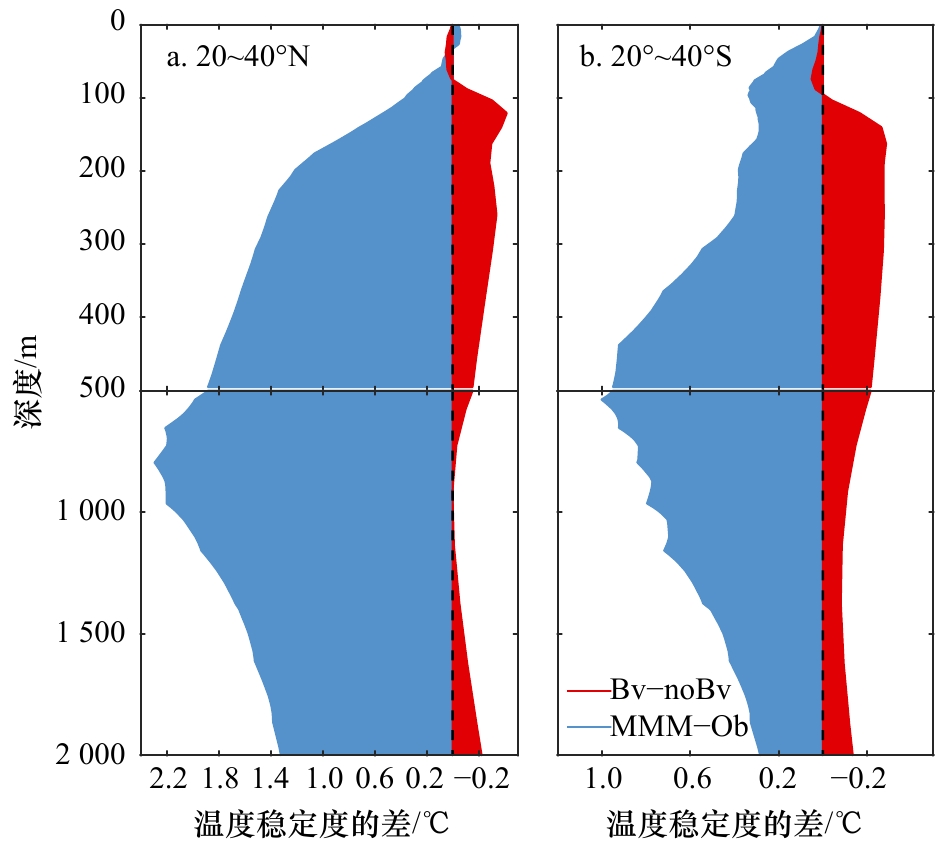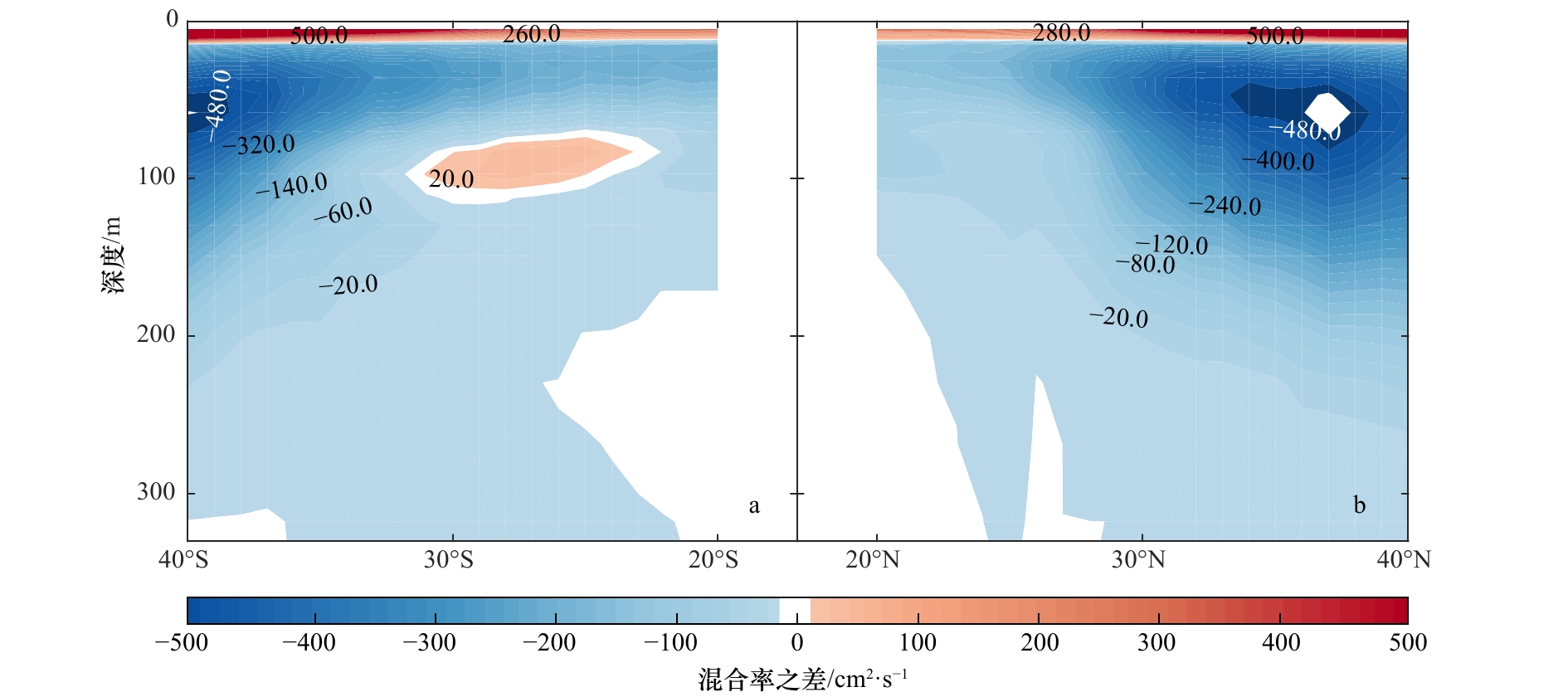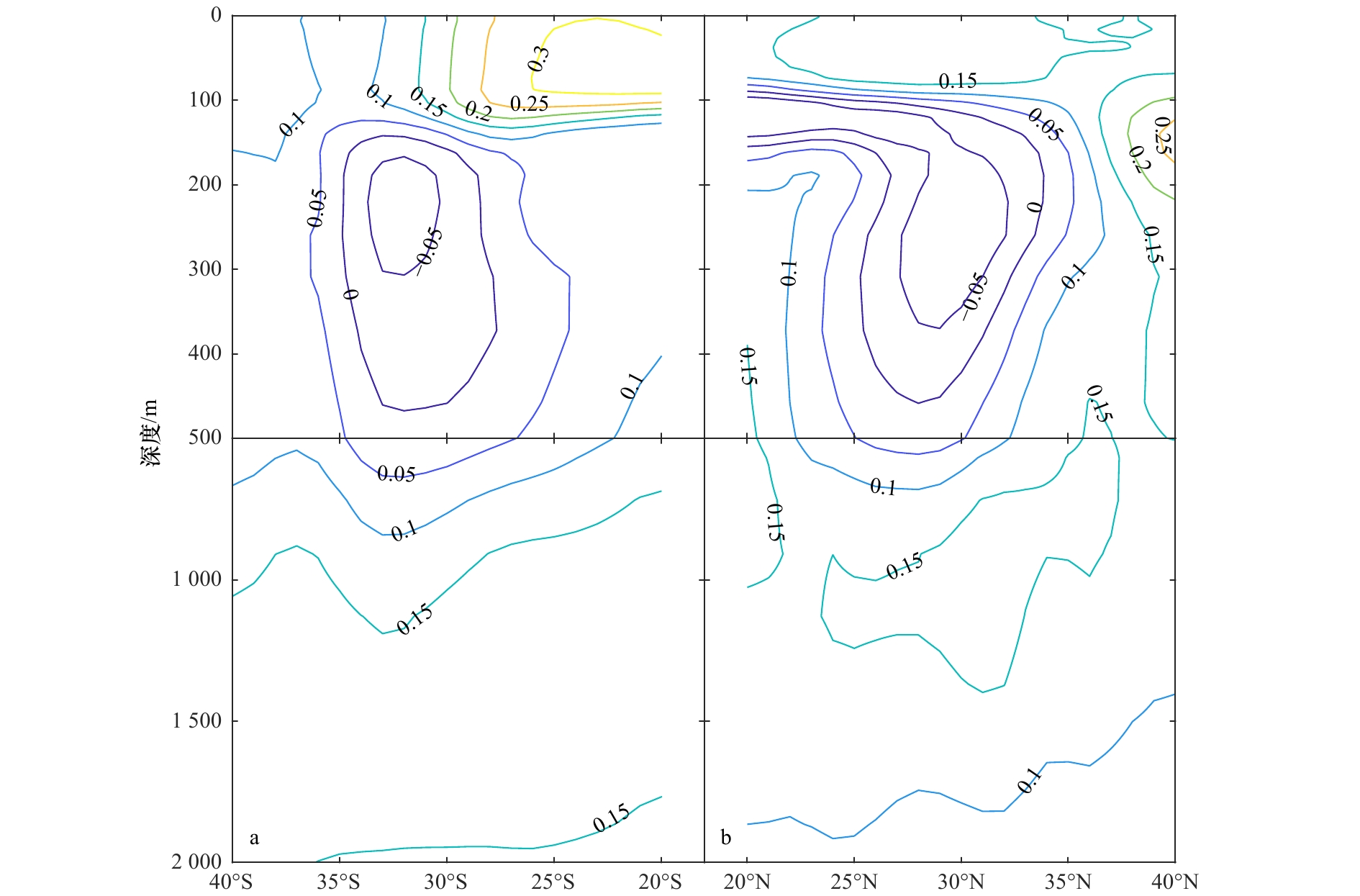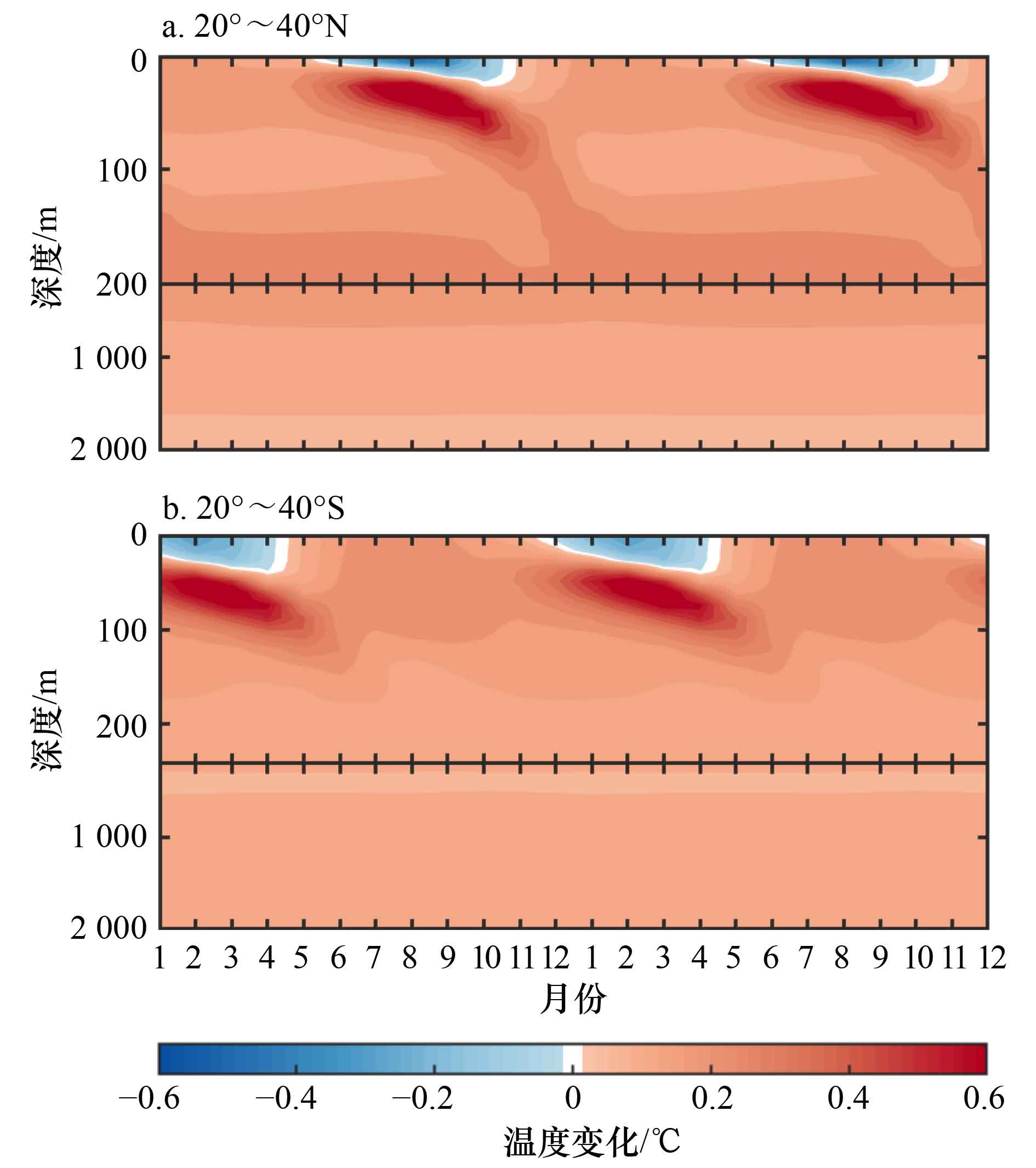The reduced winter vertical mixing in the subtropical oceans by the surface wave-induced mixing
-
摘要: 上层海洋在全球气候系统中起着至关重要的作用。对上层海洋层结及混合的模拟偏差一直是海洋和气候数值模式发展中悬而未决的问题。本文首先评估了CMIP5中45个模式对上层海洋层结模拟的偏差,确认了冬季亚热带地区海洋模式垂向混合偏强。随后,基于自然资源部第一海洋研究所地球系统模式(FIO-ESM v1.0),分别开展了1986−2005年期间包含和关闭海浪垂向混合情况下的数值实验,分析浪致混合对亚热带冬季海洋混合强度模拟的影响及机制。发现浪致混合使得气候模式中亚热带海域冬季的海洋层结增强,增强的层结使上层海洋更加稳定。首次揭示了增加浪致混合反而降低了海洋总体的垂向混合率:浪致混合使北半球冬季亚热带海域混合率从无浪实验的227 cm2/s降低到有浪实验的178 cm2/s,降低了21.6%;南半球冬季亚热带海域混合率从无浪实验的189 cm2/s降低到有浪实验的165 cm2/s,降低了12.7%。进一步分析发现,浪致混合主要是通过增加冬季亚热带海域上层海洋的热含量从而强化了海洋的层结,最终改善了气候模式对上层海洋混合的模拟。Abstract: The ocean mixing is one of the most important parameters in the global climate system. The simulation biases of the stratification and the ocean mixing are still open questions. Compared to observations, the simulated multi-model mean stratification during winter in the subtropical regions of both hemispheres shows week bias from 45 CMIP5 climate models. Our results from two numerical experiments using one of CMIP5 models, FIO-ESM v1.0, show that the non-breaking surface wave-induced vertical mixing can serve as a remedy. It increases the temperature of the upper ocean in winter which then stabilize the upper ocean and increase the stratification in subtropical regions. As a result, the stronger stratification restrains the ocean vertical mixing. The simulation of ocean mixing reduce from 227 cm/m2 to 178 cm/m2 in the north subtropical in winter, and from 189 cm/m2 to 165 cm/m2 in the south subtropical. They reduced by 21.6% and 12.7%, respectively. Further analysis indicated that the the surface wave-induced mixing strengthen the stratification by the increasing the upper ocean heat content and then improve the simulation of the ocean mixing.
-
Key words:
- ocean mixing /
- surface wave-induced mixing /
- numerical model /
- winter /
- subtropical oceans
-
表 1 CMIP5中45个气候模式情况
Tab. 1 The details of the 45 models of the CMIP5
序号 模式名称 研发机构 海洋模式 参考文献 1 ACCESS1-0 CSIRO-BOM MOM4P1 Bi[19] 2 ACCESS1-3 CSIRO-BOM MOM4P1 3 BCC-CSM1-1 BCC-CMA MOM4_L40 http://bcc.cma.gov.cn/bccsm/htm/ 4 BCC-CSM1-1-m BCC-CMA MOM4_L40 5 CanESM2 CCCMA CanOM4 Chylek等[20] 6 CCSM4 NCAR POP2 Danabasoglu等[21] 7 CESM1-BGC NSF-DOE-NCAR POP2 8 CESM1-CAM5 NSF-DOE-NCAR POP2 9 CESM1-CAM5-1-FV2 NSF-DOE-NCAR POP2 10 CESM1-FASTCHEM NSF-DOE-NCAR POP2 11 CESM1-WACCM NSF-DOE-NCAR POP2 12 CMCC-CESM CMCC OPA8.2 Madec等[22] 13 CMCC-CM CMCC OPA8.2 14 CMCC-CMS CMCC OPA8.2 15 CNRM-CM5 CNRM-CEFACS NEMOv3.3 Voldoire等[23] 16 CSIRO-Mk3-6-0 CSIRO-QCCCE MOM2.2 Gordon等[24] 17 FGOALS-g2 LASG-CESS LICOM2 Bao等[25] 18 FIO-ESM FIO-SOA POP2 Qiao等[15] 19 GFDL-CM2p1 NOAA-GFDL MOM4.0 Griffies等[26] 20 GFDL-CM3 NOAA-GFDL MOM4P1 21 GFDL-ESM2G NOAA-GFDL GOLD Dunne等[27] 22 GFDL-ESM2M NOAA-GFDL MOM4P1 23 GISS-E2-H GISS-NASA HYCOM Sun和Bleck[28] 24 GISS-E2-H-CC GISS-NASA HYCOM 25 GISS-E2-R GISS-NASA Russell Liu等[29] 26 GISS-E2-R-CC GISS-NASA Russell 27 HadCM3 MOHC HadOM3 Gordon等[30] 28 HadGEM2-AO NMA/KMAMOHC HadGOM2 Martin等[31] 29 HadGEM2-CC NMA/KMAMOHC HadGOM2 Johns等[32] 30 HadGEM2-ES NMA/KMAMOHC HadGOM2 31 INMCM4 INM INMOM Johns等[32] 32 IPSL-CM5A-LR IPSL NEMO2.3 Dufresne等[33] 33 IPSL-CM5A-MR IPSL NEMO2.3 34 IPSL-CM5B-LR IPSL NEMO2.3 35 MIROC4h MIROC COCO3.4 Sakamoto等[34] -
[1] de Boyer Montégut C, Madec G, Fischer A S, et al. Mixed layer depth over the global ocean: an examination of profile data and a profile-based climatology[J]. Journal of Geophysical Research, 2004, 109(C12): C12003. doi: 10.1029/2004JC002378 [2] Martin P J. Simulation of the mixed layer at OWS November and Papa with several models[J]. Journal of Geophysical Research, 1985, 90(C1): 903−916. doi: 10.1029/JC090iC01p00903 [3] Ezer T. On the seasonal mixed layer simulated by a basin-scale ocean model and the Mellor-Yamada turbulence scheme[J]. Journal of Geophysical Research, 2000, 105(C7): 16843−16855. doi: 10.1029/2000JC900088 [4] Belcher S E, Grant A L M, Hanley K E, et al. A global perspective on Langmuir turbulence in the ocean surface boundary layer[J]. Geophysical Research Letters, 2012, 39(18): L18605. [5] Huang Chuanjiang, Qiao Fangli, Shu Qi, et al. Evaluating austral summer mixed-layer response to surface wave–induced mixing in the Southern Ocean[J]. Journal of Geophysical Research, 2012, 117(C11): C00J18. [6] Huang Chuanjiang, Qiao Fangli, Dai Dejun. Evaluating CMIP5 simulations of mixed layer depth during summer[J]. Journal of Geophysical Research, 2014, 119(4): 2568−2582. [7] Kuhlbrodt T, Gregory J M. Ocean heat uptake and its consequences for the magnitude of sea level rise and climate change[J]. Geophysical Research Letters, 2012, 39(18): L18608. [8] Forest C E, Stone P H, Sokolov A P. Estimated PDFs of climate system properties including natural and anthropogenic forcings[J]. Geophysical Research Letters, 2006, 33(1): L01705. [9] Forest C E, Stone P H, Sokolov A P. Constraining climate model parameters from observed 20th century changes[J]. Tellus A: Dynamic Meteorology and Oceanography, 2008, 60(5): 911−920. doi: 10.1111/j.1600-0870.2008.00346.x [10] Boé J, Hall A, Qu X. Deep ocean heat uptake as a major source of spread in transient climate change simulations[J]. Geophysical Research Letters, 2009, 36(22): L22701. doi: 10.1029/2009GL040845 [11] Sokolov A P, Forest C E, Stone P H. Sensitivity of climate change projections to uncertainties in the estimates of observed changes in deep-ocean heat content[J]. Climate Dynamics, 2010, 34(5): 735−745. doi: 10.1007/s00382-009-0556-1 [12] Griffies S M, Greatbatch R J. Physical processes that impact the evolution of global mean sea level in ocean climate models[J]. Ocean Modelling, 2012, 51: 37−72. doi: 10.1016/j.ocemod.2012.04.003 [13] Ilıcak M, Adcroft A J, Griffies S M, et al. Spurious dianeutral mixing and the role of momentum closure[J]. Ocean Modelling, 2012, 45-46: 37−58. doi: 10.1016/j.ocemod.2011.10.003 [14] Flato G, Marotzke J, Abiodun B, et al. Evaluation of climate models[M]//IPCC. Climate Change 2013: The Physical Science Basis. Contribution of Working Group I to the Fifth Assessment Report of the Intergovernmental Panel on Climate Change. Cambridge: Cambridge University Press, 2013. [15] Qiao Fangli, Song Zhenya, Bao Ying, et al. Development and evaluation of an Earth System Model with surface gravity waves[J]. Journal of Geophysical Research, 2013, 118(9): 4514−4524. [16] Chen Siyu, Qiao Fangli, Huang Chuanjiang, et al. Effects of the non-breaking surface wave-induced vertical mixing on winter mixed layer depth in subtropical regions[J]. Journal of Geophysical Research, 2018, 123(4): 2934−2944. [17] Schmidtko S, Johnson G C, Lyman J M. MIMOC: a global monthly isopycnal upper-ocean climatology with mixed layers[J]. Journal of Geophysical Research, 2013, 118(4): 1658−1672. [18] Sallée J B, Shuckburgh E, Bruneau N, et al. Assessment of Southern Ocean mixed-layer depths in CMIP5 models: historical bias and forcing response[J]. Journal of Geophysical Research, 2013, 118(4): 1845−1862. [19] Bi Daohua. The ACCESS coupled model: description, control climate and evaluation[J]. Australia Meteorological Oceanography, 2013, 63(1): 41−64. doi: 10.22499/2.6301.004 [20] Chylek P, Li J, Dubey M K, et al. Observed and model simulated 20th century Arctic temperature variability: Canadian earth system model CanESM2[J]. Atmospheric Chemistry and Physics, 2011, 11(8): 22893−22907. [21] Danabasoglu G, Bates S C, Briegleb B P, et al. The CCSM4 ocean component[J]. Journal of Climate, 2012, 25(5): 1361−1389. doi: 10.1175/JCLI-D-11-00091.1 [22] Madec G, Delecluse P, Imbard M, et al. OPA 8.1 ocean general circulation model reference manual[R]. Paris: Institut Pierre-Simon Laplace, 1998. [23] Voldoire A, Sanchez-Gomez E, Salas y Mélia D, et al. The CNRM-CM5.1 global climate model: description and basic evaluation[J]. Climate Dynamics, 2013, 40(9/10): 2091−2121. [24] Gordon H B, O’Farrell S P, Collier M A, et al. The CSIRO Mk3.5 climate model[R]. Aspendale: CAWCR, 2010. [25] Bao Qing, Lin Pengfei, Zhou Tianjun, et al. The flexible global ocean-atmosphere-land system model, spectral version 2: FGOALS-s2[J]. Advances in Atmospheric Sciences, 2013, 30(3): 561−576. doi: 10.1007/s00376-012-2113-9 [26] Griffies S M, Winton M, Donner L J, et al. The GFDL CM3 coupled climate model: characteristics of the ocean and sea ice simulations[J]. Journal of Climate, 2011, 24(13): 3520−3544. doi: 10.1175/2011JCLI3964.1 [27] Dunne J P, John J G, Shevliakova E, et al. GFDL's ESM2 global coupled climate-carbon earth system models. Part II: carbon system formulation and baseline simulation characteristics[J]. Journal of Climate, 2013, 26(7): 2247−2267. doi: 10.1175/JCLI-D-12-00150.1 [28] Sun Shan, Bleck R. Multi-century simulations with the coupled GISS–HYCOM climate model: control experiments[J]. Climate Dynamics, 2006, 26(4): 407−428. doi: 10.1007/s00382-005-0091-7 [29] Liu Jiping, Schmidt G A, Martinson D G, et al. Sensitivity of sea ice to physical parameterizations in the GISS global climate model[J]. Journal of Geophysical Research, 2003, 108(C2): 3053. [30] Gordon C, Cooper C, Senior C A, et al. The simulation of SST, sea ice extents and ocean heat transports in a version of the Hadley Centre coupled model without flux adjustments[J]. Climate Dynamics, 2000, 16(2/3): 147−168. doi: 10.1007/s003820050010 [31] Martin G M, Bellouin N, Collins W J, et al. The HadGEM2 family of Met Office Unified Model climate configurations[J]. Geoscientific Model Development, 2011, 4(3): 723−757. doi: 10.5194/gmd-4-723-2011 [32] Johns T C, Durman C F, Banks H T, et al. The new Hadley Centre climate model (HadGEM1): evaluation of coupled simulations[J]. Journal of Climate, 2006, 19(7): 1327−1353. doi: 10.1175/JCLI3712.1 [33] Dufresne J L, Foujols M A, Denvil S, et al. Climate change projections using the IPSL-CM5 Earth System Model: from CMIP3 to CMIP5[J]. Climate Dynamics, 2013, 40(9-10): 2123−2165. doi: 10.1007/s00382-012-1636-1 [34] Sakamoto T T, Komuro Y, Nishimura T, et al. MIROC4h—A new high-resolution atmosphere-ocean coupled general circulation model[J]. Journal of the Meteorological Society of Japan, 2012, 90(3): 325−359. doi: 10.2151/jmsj.2012-301 [35] Watanabe M, Suzuki T, O’ishi R, et al. Improved climate simulation by MIROC5: mean states, variability, and climate sensitivity[J]. Journal of Climate, 2010, 23(23): 6312−6335. doi: 10.1175/2010JCLI3679.1 [36] Watanabe S, Hajima T, Sudo K, et al. MIROC-ESM 2010: model description and basic results of CMIP5-20c3m experiments[J]. Geoscientific Model Development, 2011, 4(4): 845−872. doi: 10.5194/gmd-4-845-2011 [37] Jungclaus J H, Fischer N, Haak H, et al. Characteristics of the ocean simulations in the Max Planck Institute Ocean Model (MPIOM) the ocean component of the MPI-earth system model[J]. Journal of Advances in Modeling Earth Systems, 2013, 5(2): 422−446. doi: 10.1002/jame.20023 [38] Yukimoto S, Adachi Y, Hosaka M, et al. A new global climate model of the meteorological research institute: MRI-CGCM3—model description and basic performance[J]. Journal of the Meteorological Society of Japan, 2012, 90A: 23−64. doi: 10.2151/jmsj.2012-A02 [39] Bentsen M, Bethke I, Debernard J B, et al. The Norwegian Earth System Model, NorESM1-M Part 1: Description and basic evaluation[J]. Geoscientific Model Development Discussions, 2013(6): 687−720. -




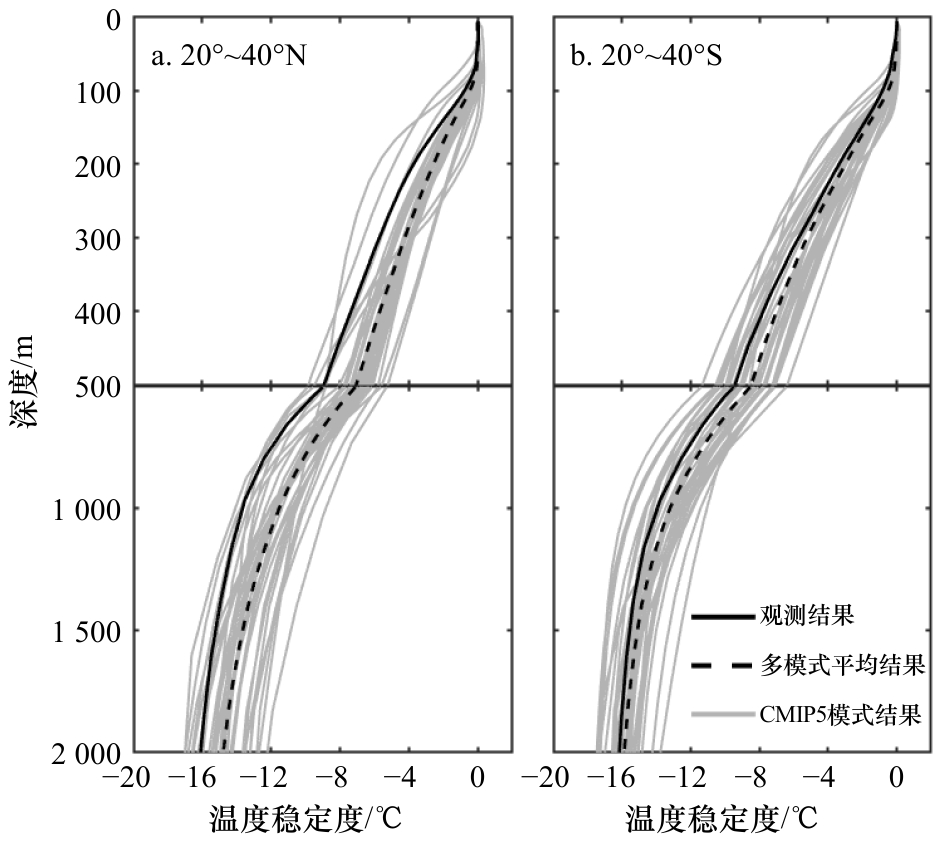
 下载:
下载:

